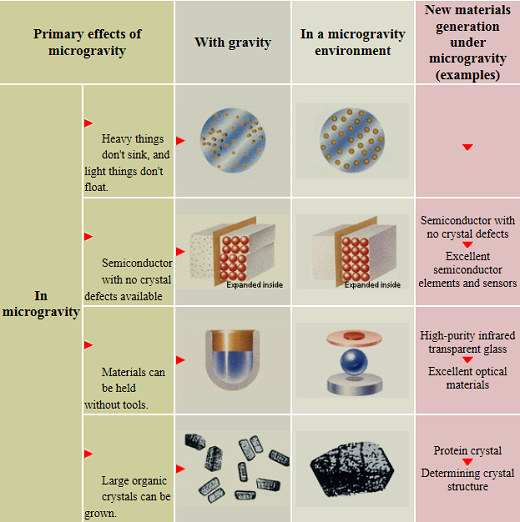This is an archive of information released in the past.
Disclaimer: It may contain broken links or outdated information. Some parts may not function in current web browsers.
*Visit https://humans-in-space.jaxa.jp/en/ for the latest information.

Experiment
- News
- Kibo Utilization Strategy
- Kibo Utilization Plan
- List of JAXA's Utilization Themes
- Experiment Facilities
- Space Environment Utilization
- Archive
Features of Space Environment
The space environment has features which can't be easily obtained on the ground, such as microgravity, high level of vacuum, excellent visibility, and space radiation. A variety of fields of research and experiments or observations is expected to utilize these features.
In microgravity environment
- Since there is almost no buoyancy in the space environment, light materials and heavy materials can be mixed uniformly.
- Defect-free crystal structures can be formed because there is almost no weight or depth pressure.
- Materials can be held without using a melting pot, so contamination impurities will be reduced.
These features will enable researchers to perform research which will bring about scientific and engineering evolutions, such as discovering and exploiting phenomena peculiar to the space environment or creating new material or medicines. Also, research to clarify the effects of gravity on biological structures and functions, such as development, differentiation, and growth of living things on the Earth will be able to be performed. Kibo will be attached to the International Space Station (ISS) and will provide a several micro-g environment.

High-level vacuum
Space provides a large-scale high-level vacuum environment which can never be obtained on the ground. The level of space vacuum depends on the altitude above the Earth. At the ISS altitude about 400km (250mi), the pressure of the environment is about one 100,000th of 1Pa, which is about 0ne 100 milllionth of the pressure on the ground. Utilizing the features of this high-level vacuum and microgravity, pure materials can be produced from the melted state with a purity which can never been realized on the ground. High-quality semiconductors are also expected to be produced utilizing the high- level vacuum.
Excellent visibility
Visibility for observing space is excellent since there is almost no atmosphere and no meteorological effects in space close to the Earth. The whole Earth can be observed from outside of the atmosphere. Abundant, constant, and high-density solar energy is also available.
Space radiation
Space is full of ionized radiation and solar radiation such as gamma rays, x-rays, and ultraviolet rays. The space radiation environment is composed of various types of particles. These include a radiation belt consisting of particles captured by the Earth's magnetic field and surrounding the Earth like a donut; protons with energies ranging from 10 through 1016 Mev; galactic radiation composed of many types of nuclei such as helium, carbon, oxygen, and iron; and high levels of particles generated by solar flares. Utilizing such an environment, various types of research can be conducted in the fields of life science, medicine and so on. For instance, research on the adaptability and ecology of living things in the space environments and research on physical effects of radiation on living things and mankind can be performed.
| Copyright 2007 Japan Aerospace Exploration Agency | Site Policy |